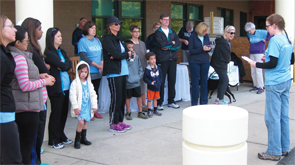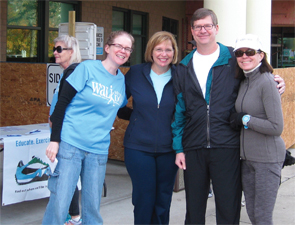
Dr. Nelson gave a presentation to the group assembled for the inaugural Walk with a Doc event in October 2015.
“No more excuses.” At least, that’s what Amanda Nelson, MD, MSCR, now tells her patients.
As a rheumatologist, assistant professor in the School of Medicine at the University of North Carolina at Chapel Hill (UNC) and clinical researcher at UNC’s onsite Thurston Arthritis Research Center, Dr. Nelson says patients often provide a litany of legitimate—and sometimes not-so-legitimate—excuses for why they don’t exercise, anything from bad weather or lacking a walking partner to, “I’ll do it tomorrow.”
However, back in October 2015, Dr. Nelson read an online article about David Sabgir, MD, a cardiologist in Columbus, Ohio, who grew so frustrated with his sedentary patients that he introduced a new program and nonprofit called, Walk with a Doc. The 11-year-old membership organization, which now supports 2,000 physicians in 40 different states, encourages physicians to lead monthly walks with their patients. Physicians pay a one-time $500 membership fee in exchange for liability insurance, pedometers and marketing materials (e.g., posters, banners, prescription pads and T-shirts that bear the organization’s logo).

Dianne Rosenbluth (background), honorary co-chair of the Osteoarthritis Action Alliance. From left: Amanda Nelson, MD, MSCR; Beth Jonas, MD, associate professor and rheumatology program director; Richard Loeser, MD: professor and director of basic and translational research at the Thurston Arthritis Research Center (TARC); and Joanne Jordan, MD, MPH, professor, division chief, rheumatology, allergy and immunology, and director of TARC.
Dr. Nelson immediately signed up and became the organization’s first member rheumatologist. Since then, she has led her patients in walking one mile near the university’s campus every month. Her goal is to spread the program to more patients with rheumatologic and non-rheumatologic conditions who would benefit from exercise. But what she especially likes about the program is that unlike research, which can take many years before patient benefits are realized, walking with patients provides immediate benefits.
Promote & Participate
Since this past October, Dr. Nelson has conducted her monthly walks from 11 a.m. to noon on the third Saturday of each month at the UNC Wellness Center at Meadowmont in Chapel Hill. She explains that anyone can use the facility’s mile path that loops around the center’s grounds.
“In addition to encouraging patients to engage in physical activity and make it part of their routine, [walking with them] also gives them an opportunity to spend some informal, non-office-based time with their providers,” she explains, adding that the mile walk typically takes 30 minutes. “We get out and walk and are able to answer questions from our patients. They informally hang out with us and with our staff. A lot of people really enjoy that.”

